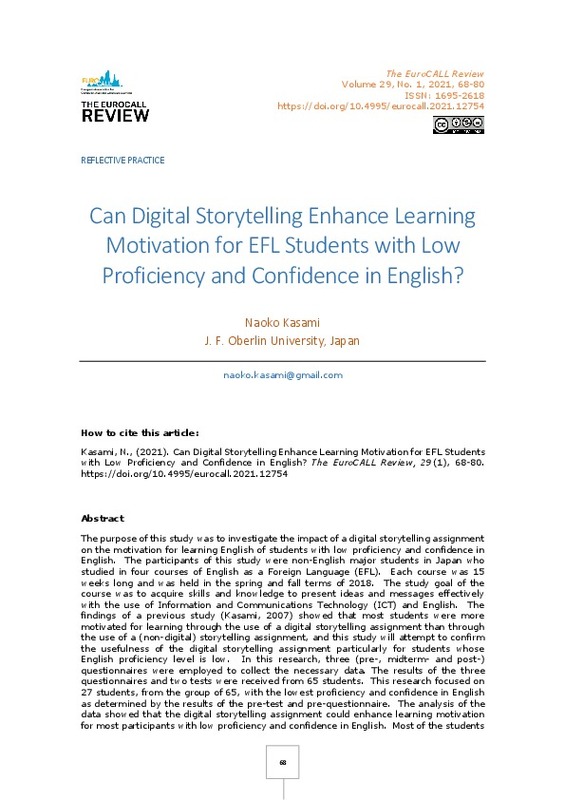Abdel-hack, E. M., & Helwa, A. A. (2014). Using digital storytelling and weblogs instruction to enhance EFL narrative writing and critical thinking skills among EFL majors at faculty of education. International Research Journal, 5(1): 8-41.
Baturay, M., Daloglu, A. & Yildirim, S. (2010). Language practice with multimedia supported web-based grammar revision material. ReCALL, 22(3): 313-331. https://doi.org/10.1017/S0958344010000182
Castañeda, M. E. (2013). "I am proud that I did it and it's a piece of me": Digital storytelling in the foreign language classroom, CALICO Journal, 30(1): 44-62. https://doi.org/10.11139/cj.30.1.44-62
[+]
Abdel-hack, E. M., & Helwa, A. A. (2014). Using digital storytelling and weblogs instruction to enhance EFL narrative writing and critical thinking skills among EFL majors at faculty of education. International Research Journal, 5(1): 8-41.
Baturay, M., Daloglu, A. & Yildirim, S. (2010). Language practice with multimedia supported web-based grammar revision material. ReCALL, 22(3): 313-331. https://doi.org/10.1017/S0958344010000182
Castañeda, M. E. (2013). "I am proud that I did it and it's a piece of me": Digital storytelling in the foreign language classroom, CALICO Journal, 30(1): 44-62. https://doi.org/10.11139/cj.30.1.44-62
Chang, M. M., & Lehman, J. D. (2002). Learning foreign language through an interactive multimedia program: An experimental study on the effects of the relevance component of the ARCS model. CALICO Journal, 20(1): 81-89. https://doi.org/10.1558/cj.v20i1.81-98
Dörnyei, Z. (2001). Teaching and Researching Motivation. Harlow: Pearson Education Limited.
Dörnyei, Z. (2005). The psychology of the language learner: Individual differences in second language acquisition. London: Lawrence Erlbaum Associates Publishers.
Dörnyei, Z. (2007). Creating a motivating classroom environment. In Cummins, J. & Davison, C. (Eds.), International handbook of English language teaching, 2, New York: Springer, 719-731. https://doi.org/10.1007/978-0-387-46301-8_47
Kasami, N. (2014). The impacts of a digital storytelling assignment on non-English-major students' motivation for learning English in a Japanese university. In L. Liu & D. Gibson (Eds), Research highlights in technology and teacher education. Waynesville: Association for the Advancement of Computing in Education (AACE), 91-100.
Kasami, N. (2017). The comparison of the impact of storytelling and digital storytelling assignments on students' motivations for learning. Proceedings of the EUROCALL 2017 Conference. CALL in a climate of change: adapting to turbulent global conditions. University of Southampton, 23-26 August. Research-publishing.net, https://doi.org/10.14705/rpnet.2017.eurocall2017.709
Keller, J.M. (1983). Motivational design of instruction. In C. M. Reigeluth (ed.), Instructional design theories and models: An overview of their current status, Hillsdale, NJ: Lawrence Erlbaum Associates, 383-434.
Keller, J. M. (1987). Development and use of the ARCS model of instructional design. Journal of Instructional Development, 10(3): 2-10.
Keller, J. M. (2010). Motivational design for learning and performance: The ARCS model approach. New York: Springer. https://doi.org/10.1007/978-1-4419-1250-3
Kikuchi, K. (2013). Demotivators in the Japanese EFL context. In Apple, M. T., Silva, D. D. & Fellner, T. (eds.), Language Learning Motivation in Japan, Bristol: Multilingual Matters, 206-224. https://doi.org/10.21832/9781783090518-014
Liu, C. C., Wang, P. C. & Tai, S. J. D. (2016). An analysis of student engagement patterns in language learning facilitated by Web 2.0 technologies. ReCALL, 28(2): 104-122. https://doi.org/10.1017/S095834401600001X
Macaro, E., Handley, Z. & Walter, C. (2012). A systematic review of CALL in English as a second language: Focus on primary and secondary education. Language Teaching, 45(1): 1-43. https://doi.org/10.1017/S0261444811000395
Morizumi, M. (2019). The opening article, "Eigo no Jugyo de kotoba heno kiduki wo" [English language lessons for developing language awareness], The new English classroom 598, Tokyo: New English Teachers' Association. (in Japanese)
Ohler, J. B. (2013). Digital storytelling in the classroom: New media pathways to literacy, learning, and creativity. Corwin Press. https://doi.org/10.4135/9781452277479
Oskoz, A. & Elola, I. (2016). Digital stories: Bringing multimodal texts to the Spanish writing classroom. ReCALL, 28(3): 326-342. https://doi.org/10.1017/S0958344016000094
Ribeiro, S. (2015). Digital storytelling: An integrated approach to language for the 21st century student. Teaching English with Technology, 15(2): 39-53.
Robin, B. (2006). The Educational Uses of Digital Storytelling. Proceedings of SITE 2006, 709-716. Orlando, Florida: Association for the Advancement of Computing in Education (AACE).
Song, S. H. & Keller, J. M. (2001). Effectiveness of motivationally adaptive computer-assisted instruction on the dynamic aspects of motivation. Educational Technology, Research and Development, 49(2): 5-22. https://doi.org/10.1007/BF02504925
StoryCenter Website, Digital Storytelling for Educators. https://www.storycenter.org/public-workshops/edu-intro-to-ds (Last accessed: January 22, 2021)
Suzuki, K., Nishibuchi, A., Yamamoto, M., & Keller, J. M. (2004). Development and evaluation of website to check instructional design based on the ARCS motivation model. Information and Systems in Education, 2(1): 63-69.
[-]








